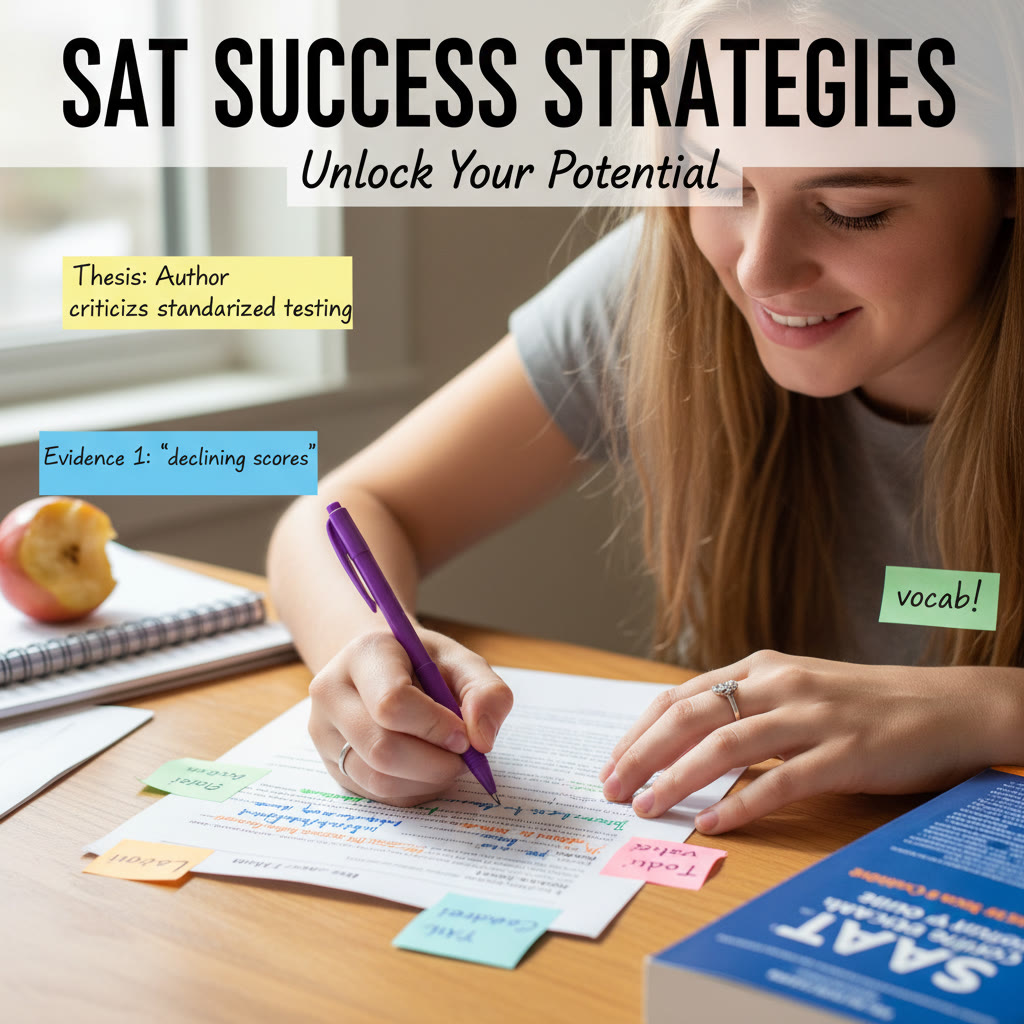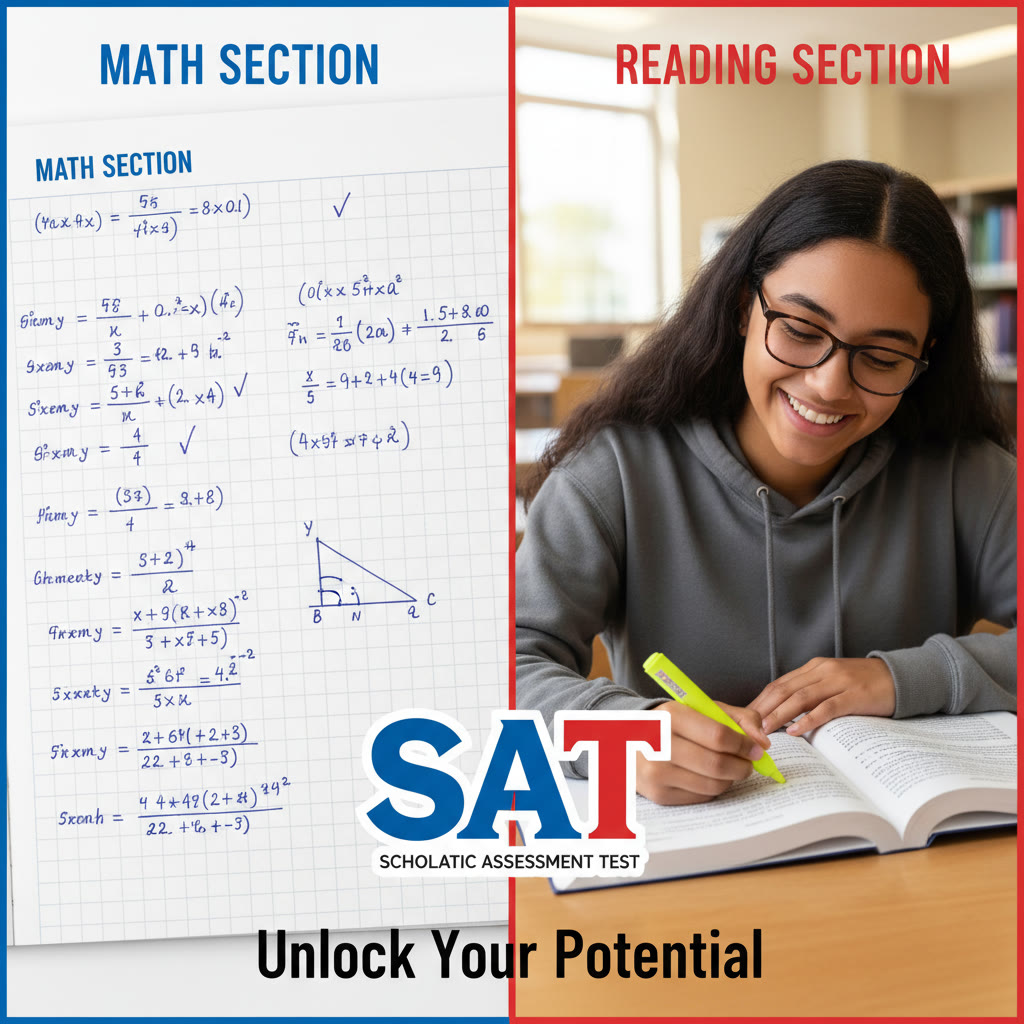Why Some Students Excel in SAT Math But Struggle in Reading
It’s a common scene: a student lights up when they get a list of math problems — algebra feels like a puzzle they can decode — yet they freeze when faced with a dense passage and six evidence-based questions. If this sounds familiar, you’re not alone. The SAT measures different kinds of thinking. Excelling in one domain doesn’t guarantee the other, and that’s okay. The goal of this post is to explain why this happens, make the reasons feel actionable, and give you a realistic, friendly plan to bring your Reading score up to match your Math performance.
Quick snapshot: Different muscles, different workouts
Think of Math and Reading like two athletic events. Math is often about sprinting with practiced steps: pattern recognition, formulas, structured problem-solving. Reading is more like a long, strategy-filled climb: comprehension, inference, integrating information, and handling nuance. Many students have trained their “math muscles” more — through repeated practice, immediate feedback, and clear right-or-wrong answers — while their “reading endurance” hasn’t had the same targeted work.
Why the gap exists: cognitive and instructional reasons
Let’s unpack the main reasons students can be strong in SAT Math but shaky in SAT Reading.
1. Different cognitive skills
- Pattern recognition vs. interpretation: Math rewards pattern spotting and procedural fluency. Reading rewards interpretation, synthesis, and judgment about nuance.
- Working memory and processing speed: Math problems often guide you step-by-step; Reading requires keeping multiple ideas in mind across a paragraph or passage.
- Vocabulary and background knowledge: Reading comprehension can depend on knowledge of idioms, context, and subject matter. A student might be comfortable with math vocabulary (terms and symbols) but less confident with academic vocabulary or historical/scientific context.
2. Educational exposure and practice habits
Many students get heavy, structured practice in math from early grades — homework with immediate answers, tutoring that zeroes in on weak steps, and standardized drills. Reading practice is often less structured: assigned novels, optional annotations, or classroom discussions that don’t translate directly to SAT-style evidence-based questions. The SAT Reading section has its own rules; without targeted practice, general reading skills don’t always transfer.
3. The test’s format and measurable feedback
Math problems produce clear right-or-wrong outcomes and often come with a satisfying sense of progress. When you practice geometry, you know whether an approach works. Reading answers can feel subjective: you might choose an answer that “sounds right” but isn’t the best evidence-based choice. This fuzzy feedback loop makes it harder to improve without guided review.
4. Anxiety and time management
A student who thrives in a focused, rule-based environment (math) might find the open-ended nature of passages stressful. Time pressure compounds this: math questions often have predictable time demands, but long passages require pacing strategies and stamina to avoid rushing through inference-based questions.
5. Misapplied strategies
Students sometimes try to apply the efficient, algorithmic approach from math to reading — skimming for keywords and plugging in quick answers. That works for some literal questions but fails for subtle inference or evidence-based questions that require deeper engagement with the text.
Real examples: What this looks like on the SAT
Here are two short, fictional vignettes that show the difference.
Example A: The Math whiz
Daniel breezes through an algebra set. When he sees a system of equations, he instantly recognizes substitution as the fastest path. He finishes the Math section with several minutes to spare. But he gets stuck on a Reading passage about a historical figure because the author’s tone and implied criticisms require reading between the lines — a skill Daniel hasn’t rehearsed often.
Example B: The Literal Reader
Sophia reads carefully and remembers every factual detail but struggles with questions that ask “Which choice best captures the author’s attitude?” She can locate quotes but hesitates to interpret connotation. Her math score is solid because she knows formulas, but she misses the subtle inference questions that require combining facts and tone.
Strategies to close the gap
Improving Reading takes focused practice, habits you can repeat, and strategies to translate your logical math thinking into analytical reading skills. The good news: many strengths you use in math — attention to detail, systematic problem-solving, and error-checking — are transferable. Here’s how to do it.
1. Treat Reading like a solvable problem
- Break questions into parts: What does the question ask? What’s the scope (line reference, paragraph, entire passage)? What type of reasoning is required (detail, inference, function, vocabulary in context)?
- Annotate with purpose: Instead of underlining everything, note the passage’s main idea in two words, mark shifts in tone with a short symbol, and flag evidence lines.
2. Build targeted vocabulary — with context
Don’t memorize isolated word lists. Learn words in sentences, notice affixes and roots, and practice replacing a word in a sentence to see how meaning changes. This mirrors the SAT approach: most vocabulary questions are about context, not obscure definitions.
3. Practice active reading
- Ask quick, simple questions after each paragraph: “What’s the point here?” “How does this connect to the thesis?”
- Summarize a paragraph in one sentence. If you can’t, go back and re-read with focus.
4. Use process-of-elimination like you do in math
In math you cross out impossible choices. Apply the same logic to reading: eliminate answers that are too broad, too specific, or unsupported by the text. The SAT loves answer choices that are partly true but not fully supported — practice spotting partial truths.
5. Practice with purpose and review thoroughly
Quality trumps quantity. Instead of 10 untimed passages, do 3 timed ones and spend as much time reviewing every wrong and uneasy answer as you spent taking the test. Ask: Why is this wrong? Which text line rules it out?
6. Manage time with micro-deadlines
Break the reading section into bite-sized targets. For example: complete passage 1 in 12 minutes, then briefly review flagged questions for 1–2 minutes. Learn to move on if a question is taking too long, returning later with fresher perspective.
Actionable practice plan (6 weeks)
This plan assumes you have a decent math baseline and want to strengthen Reading efficiently. Adjust pace to fit your schedule. The table below summarizes a focused, balanced routine that builds skills progressively.
| Week | Focus | Activities | Weekly Time |
|---|---|---|---|
| 1 | Foundations: Annotation + Structure |
|
6–8 hours |
| 2 | Vocabulary in Context |
|
6–8 hours |
| 3 | Inference & Tone |
|
7–9 hours |
| 4 | Evidence-based reasoning |
|
7–9 hours |
| 5 | Timed stamina |
|
8–10 hours |
| 6 | Polish & strategy review |
|
8–10 hours |
How to use the table
Consistency matters. If you have less time per week, stretch the plan to 10–12 weeks. If you have more, push the difficulty of passages and shorten review cycles. Keep a notebook or digital doc of recurring errors — this becomes your fastest shortcut to improvement.
Study drills and micro-exercises
Short, focused drills are great for building habits without burning out.
- Sentence-summary drill: Read a paragraph and write one 10–12 word summary. If you struggle, underline the clause that carries the main idea.
- Evidence match: For a given claim in the passage, list two lines that best support it. Practice paraphrasing each line.
- Timed micro-passages: Read a 300-word passage in 3 minutes; then answer 4 questions in 6 minutes. Focus on accuracy before speed.
How your math strengths help — and how to transfer them
If you enjoy math, you already have tools that can boost Reading:
- Logical structure: Math trains you to notice structure. Use that to map passage structure: premise, evidence, counterargument, conclusion.
- Precision: Math demands precise language. Apply the same care to answer choices: spot tiny words that change meaning (most, some, usually, rarely).
- Systematic elimination: Use your familiar process-of-elimination to discard answers that contradict the text.
Transferring these skills takes deliberate practice. For instance, after reading each paragraph, sketch a mini-outline with labeled parts (claim, evidence, example). That replicates the stepwise approach you use in algebra and makes the passage less nebulous.
Common pitfalls and how to fix them
- Reading too fast: You skim and miss the author’s attitude. Fix: slow down for the first paragraph to anchor the main idea, then skim subsequent paragraphs for function and evidence.
- Over-reliance on background knowledge: You assume the author’s meaning based on what you already know. Fix: anchor every inference in the passage — the SAT rewards text-based reasoning.
- Neglecting paired evidence questions: You pick a primary answer and skip the evidence pair. Fix: always find supporting lines immediately; it prevents careless errors.
How personalized tutoring can speed the process
Independent study works, but targeted guidance shortens the learning curve. A tutor or coach can diagnose your exact error patterns and introduce corrections you might not see on your own. For students who are strong in math but lagging in reading, tailored help can shift habits quickly: targeted drills, modeled thinking-aloud strategies, and accountability to practice goals.
If you’re exploring support, Sparkl’s personalized tutoring can be a natural fit: 1-on-1 guidance to diagnose where your reading breakdowns happen, tailored study plans to align with your existing math strengths, expert tutors who show strategies in-the-moment, and AI-driven insights that highlight recurring errors. All these pieces can speed improvement, especially when time is limited.
Measuring progress: what to track
Improvement isn’t just a higher score on a practice test. Track the following metrics to understand real growth:
- Percent correct on each question type (detail, inference, function, vocabulary)
- Average time per passage and per question
- Recurring error categories (misreadings, rushed errors, unsupported inferences)
- Confidence vs. accuracy (do you feel sure about wrong answers?)
These data points guide efficient adjustment: if inference questions are your Achilles’ heel, spend more time on those through targeted drills rather than more general reading.
Two realistic practice session examples
Short session (30–45 minutes)
- Warm-up: 5 minutes of vocabulary-in-context practice (10 sentences)
- Main: One timed passage (12–13 minutes), answer all questions
- Review: 15–20 minutes analyzing each wrong answer and writing the exact line(s) that disprove the incorrect choices
Long session (90–120 minutes)
- Warm-up: 10 minutes—review your week’s error log
- Main: Two full Reading sections, timed under test conditions
- Deep review: 45 minutes—make a correction plan, write down alternate strategies for each mistake
Image suggestions


Final thoughts: growth is predictable and enjoyable
If you’re strong in math and struggling with Reading, remember two things: first, the gap is common and surmountable; second, your math strengths are assets you can leverage. With a structured plan, targeted drills, and thoughtful review, you’ll start to see patterns and gains — and those gains compound fast.
Start small: pick one passage type (history, science, or literature) and attack it for two weeks with the focused drills above. Track your errors. Celebrate small wins — like correctly identifying tone or efficiently backing up an answer with a line citation. If you want bespoke acceleration, consider putting those strengths into a personalized plan with help from an expert tutor. Sparkl’s personalized tutoring can offer the kind of tailored feedback and AI-driven insights that make each session more efficient — but the most important ingredient is your steady, curious practice.
One last piece of encouragement: reading is a skill that becomes more enjoyable the more you do it. What starts as a chore — figuring out exactly what each line contributes — will become one of your favorite analytical exercises. You’ll begin to approach passages like a detective: following clues, building a case, and arriving at evidence-backed answers with the same satisfaction you get from solving a tough math problem.
Go out and practice with intention
Choose one specific target for this week (e.g., inference accuracy or timed stamina), commit to the micro-exercises, and keep a short error log. The combination of deliberate practice, smart strategy, and occasional personalized tutoring will get your Reading score to match your Math strength — and the process will sharpen thinking skills you’ll use long after the SAT is behind you.

















No Comments
Leave a comment Cancel